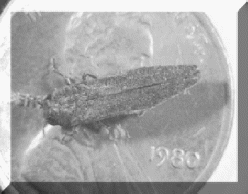

To send a message to an author, click on the author's name at the end of the article.
This Month in Ag Connection | Ag Connection - Other Issues Online
Even though cattle producers are currently focused on the issue of higher input costs, there is another issue looming on the horizon. It is the Country of Origin Labeling (COOL) law that goes into effect on September 30th of this year.

The implementation of COOL has been delayed by Congress several times. The first delay occurred in 2004 and the second in 2006. However, this time around there seems to be no indication that implementation will be delayed again. Therefore, beef cattle producers and those who produce veal, lamb, chicken, goat and pork should begin thinking about the records they will need to have this fall in order to be COOL compliant.
The only indication of the record requirements at this point is based upon the wording in the interim final rule released by the USDA on July 28th which states, "Records maintained in the course of normal conduct of the business of such person, including animal health papers, import or customs documents, or producer affidavits, may serve as such verification". The USDA and NCBA recommends that producers should start keeping records -- any records -- of livestock movement onto and off of their farms.
Here are some simple things producers can do to help them become COOL compliant this fall:
In the end, it is important to understand that the USDA will use the first six months following September 30th to educate the public and industry on the provisions and requirements of COOL. Up until that time, keeping the records mentioned above is a good way to start preparing for COOL. For more information visit http://www.ams.usda.gov/AMSv1.0/COOL.
(Source: Dr. Craig Payne, MU Beef Veterinary Extension Specialist (573) 882-8236, payneca@missouri.edu)
This Month in Ag Connection | Ag Connection - Other Issues Online
On July 25, 2008, U.S. Department of Agriculture confirmed seven Emerald Ash Borer (EAB) beetles were caught in a trap at the Wappapello Lake Army Corps of Engineers (ACOE) Greenville Recreational Area campground in Wayne County, MO. The annual trapping and survey efforts are part of a national effort to monitor and limit the spread and impact of EAB.
The EAB is an exotic beetle that was accidentally introduced from Asia prior to 2002. Its larvae feed on and kill ash trees. It is present in parts of Illinois, Indiana, Michigan, Ohio, Pennsylvania, West Virginia, Virginia, Maryland, Ontario, Canada and now Missouri. This pest is spread primarily by the movement of infested firewood, logs and ash nursery stock.
Emerald Ash Borer has only been found in one area of Missouri. Residents should not jump to conclusion that they have an infestation but be aware of what this new potential pest looks like. Emerald Ash Borer adult beetles are an iridescent metallic green, slender and about ½ inch long. Their slender, white larvae feed just under the bark cutting off the flow of water and nutrients girdling the tree. It should be noted that the bronze birch borer, a common Missouri pest, has been confused with EAB. The adult bronze birch borer is dark green-bronze or copper-bronze and about 3/8 inch long.

Ash trees make up about 3 percent of Missouri's forests and as much as 14 percent of trees in cities and towns. "While the borer will not have a significant impact on Missouri's forest products industry," Hank Stelzer, University of Missouri Extension forester and member of the state's EAB task force said, "it could have a devastating impact in communities across the state. For example, the vast majority of the trees surrounding the Gateway Arch in St. Louis are green ash."
All survey efforts are underway to determine the extent of the infestation. Once the area of infestation has been identified further actions will be taken to contain this exotic pest. At this time, no quarantine has been established and it is premature to guess what the quarantine may entail or how large an area might be covered. Taking a proactive approach through education and public awareness will greatly help to reduce the impact of EAB in Missouri.
The way to protect ash trees is to keep them vigorous and healthy so they can resist insect attacks. No insecticides are 100 percent effective against EAB. Not bringing firewood or other wood products in from other infested states are the best ways to avoid bringing home unwanted tree pests.
A Missouri Conservationist article in the March 2007 issue described the threat from EAB: http://mdc.mo.gov/ and another publication on "hitchhiking bugs" that can be transported in firewood is at: http://mdc4.mdc.mo.gov/documents/14055.pdf .
For more current information about the emerald ash borer, see the MU web site at: http://snr.missouri.edu/forestry/extension/emeraldash.php.
(Sources: Hank Stelzer, University of Missouri Extension Forester)
This Month in Ag Connection | Ag Connection - Other Issues Online
Did you see the bright purple flowers of henbit in your lawn this spring? Would you like to get control of it? If so, fall is the time to treat for henbit.
Why? Because, henbit is a winter annual. This means that the seed germinates in the fall, matures through the winter, and then sets seed and dies in the spring. To chemically control henbit, post emergence broadleaf herbicides should be applied in the fall when the seed has just germinated -- not in the spring.
In lawns, the best ways to control weeds is to implement a proper weed control program. Chemical control can only do so much. A weak stand of turf that lacks density will soon be infested by weeds.
Therefore, a management program should be directed at improving turfgrass density and vigor in combination with a chemical control. Proper management includes mowing, watering, fertilizing and cultivation. MU Extension has a guide sheet entitled "Turf Weed Control" (G6752) that is available online or at your local MU Extension office and it lists techniques and chemicals that can be used on a variety of weeds.
For more information, contact your local agronomy specialist with University of Missouri Extension.
(Source: Joni Ross, Agronomy Specialist)
This Month in Ag Connection | Ag Connection - Other Issues Online
With the popularity of grain based biofuel production, farmers are turning to longer on-farm grain storage to meet contract requirements. Longer storage puts a greater strain on keeping grain in good condition. Winter storage is relatively easy because cooler temperatures stop most storage problems, especially stored grain insects. Warmer temperature accelerates damaging pest growth.

In preparing for fall harvests, sanitation should be the first step. This step requires a thorough cleaning of all grain residues from the grain bins, surrounding areas, in combines, trucks and augers and any nearby feed bunks or storage. Grain residues are the main sources of stored grain insect infestations. Never add new grain to bins with old grain. Do not even store new grain near left-over grain unless the insects have been eliminated. A thorough cleaning of some bins may be impossible due to their design.
The next step is to apply a residual insecticide to the complete inside surfaces and around exterior walls of the bin ideally 4 to 6 weeks ahead of filling. Spray all surfaces until wet with around a gallon of a recommended stored grain insecticide per 1,000 square feet. Some of the recommended insecticides include: Beta-Cyfluthrin; Chorpyrifos-methlyl and Deltramethrin; Malathion; Silicon dioxide, diatomaceous earth; and Methoprene. Carefully read the labels of any chemical before it is used. The bin may need to be sealed and fumigated. Fumigants are typically extremely toxic and should be used only by trained applicators certified specifically for those products.
Bins should be made as rodent and bird proof as possible. Use rodenticides and traps regularly around the bin, but no rodenticides in the bin.
Keeping grain in good condition will greatly reduce or eliminate insect problems. Stored grain moisture should be 14% or less and the grain should be within 20°F of the average outside air temperature. Producers should monitor stored grains regularly for moisture, temperature and insects. Minimum monitoring should be monthly from November to April and at least twice a month from May through October.
Application of grain protectants at harvest is justified if storage lasts 3-6 weeks at above 60°F, if summer harvested grains will be stored longer that one month or if fall-harvested crops will remain in storage beyond May or June. All protectants should be applied after the grain is dried. Recommended protectants include: Primiphos-methyl; Chorpyrifos-methlyl and Deltramethrin; Malathion; Silicon dioxide, diatomaceous earth; and Methoprene. There are labeled grain protectants available for pretreatments or as grain is being elevated into the bin. Insect populations are greatly reduced or prevented by using protectants. Always read and follow label recommendations for each product.
The areas most often infested are the grain surface and the central core. Give these sites special attention when sampling. The surface is easy first contact for insects and the central core has higher levels of trash, damaged and broken grains. However, problems may occur anywhere in the bin. Use deep bin probes, probe traps, sticky pheromone traps, and make direct observations. More than one of these methods used in combination will increase the likelihood of detecting insect infestations.
Another good management tool is to level the grain surface after filling the bin. A level surface makes managing the grain much more efficient. Leave at least 6 inches of space between the top of the leveled grain surface and the top of the bin wall.

When bin filling is complete, the grain is in condition and the grain surface is level; an insecticide should be applied to the surface to form a barrier or cap to prevent infestations. A surface treatment should be applied to all stored grain. Cap out treatments include: Primiphos-methyl; Bacillus thuringiensis or Bt; Silicon dioxide, diatomaceous earth; and Methoprene. Dichlorvos slow release "no pest strips" can be hung to reduce the number of adult Indian meal moths.
For control recommendations in farm bins see:
These are available at your county University Extension Center.
(Sources: Wayne Bailey, MU Entomologist, 573-882-2838 and Jim Jarman, Agronomy Specialist 573-642-0755.)
This Month in Ag Connection | Ag Connection - Other Issues Online
Technology that boosts efficiency in beef production will be highlighted at the University of Missouri South Farm's third annual beef field day, September 18, at the farm's Beef Research and Teaching Center.
"First thing in the morning we will present research behind feed efficiency, and then later we will show the technology," said Justin Sexten, MU Extension beef nutritionist. To increase attendance this year, organizers moved the field day from a football Saturday to a Thursday, Sexten said. Producers will be able to go on a pasture walk, see vertical-mixer demonstrations and see biofuel coproduct feed storage and handling.
Other applied technology demonstrations are "Selecting and Using Growth Implants", "Choosing Feed Additives", "Sire Selection for Feed Efficiency", and "Keys to Reproductive Program Success". Industry vendors will open their exhibits at 8:30 a.m. and continue until 4 p.m.
Registration is free; however, RSVP for lunch by calling Angie Gallatin at 573-882-2829. For more information, see http://animalsciences.missouri.edu/research/brtf/.
This Month in Ag Connection | Ag Connection - Other Issues Online
Date, place, event and contact person are:
This Month in Ag Connection | Ag Connection - Other Issues Online
Publishing Information
Ag Connection is published monthly for Northeast and Central areas of Missouri producers and is supported by the University of Missouri Extension, the Missouri Agricultural Experiment Station, and the MU College of Agriculture, Food and Natural Resources. Managing Editor: Mary Sobba.